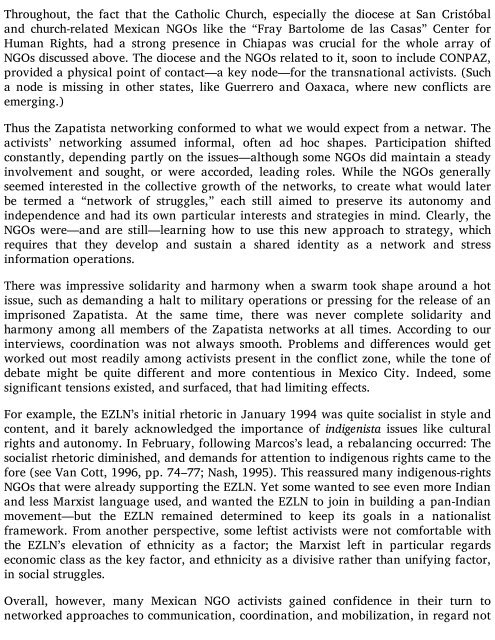RAND_MR1382
Create successful ePaper yourself
Turn your PDF publications into a flip-book with our unique Google optimized e-Paper software.
Throughout, the fact that the Catholic Church, especially the diocese at San Cristóbal<br />
and church-related Mexican NGOs like the “Fray Bartolome de las Casas” Center for<br />
Human Rights, had a strong presence in Chiapas was crucial for the whole array of<br />
NGOs discussed above. The diocese and the NGOs related to it, soon to include CONPAZ,<br />
provided a physical point of contact—a key node—for the transnational activists. (Such<br />
a node is missing in other states, like Guerrero and Oaxaca, where new conflicts are<br />
emerging.)<br />
Thus the Zapatista networking conformed to what we would expect from a netwar. The<br />
activists’ networking assumed informal, often ad hoc shapes. Participation shifted<br />
constantly, depending partly on the issues—although some NGOs did maintain a steady<br />
involvement and sought, or were accorded, leading roles. While the NGOs generally<br />
seemed interested in the collective growth of the networks, to create what would later<br />
be termed a “network of struggles,” each still aimed to preserve its autonomy and<br />
independence and had its own particular interests and strategies in mind. Clearly, the<br />
NGOs were—and are still—learning how to use this new approach to strategy, which<br />
requires that they develop and sustain a shared identity as a network and stress<br />
information operations.<br />
There was impressive solidarity and harmony when a swarm took shape around a hot<br />
issue, such as demanding a halt to military operations or pressing for the release of an<br />
imprisoned Zapatista. At the same time, there was never complete solidarity and<br />
harmony among all members of the Zapatista networks at all times. According to our<br />
interviews, coordination was not always smooth. Problems and differences would get<br />
worked out most readily among activists present in the conflict zone, while the tone of<br />
debate might be quite different and more contentious in Mexico City. Indeed, some<br />
significant tensions existed, and surfaced, that had limiting effects.<br />
For example, the EZLN’s initial rhetoric in January 1994 was quite socialist in style and<br />
content, and it barely acknowledged the importance of indigenista issues like cultural<br />
rights and autonomy. In February, following Marcos’s lead, a rebalancing occurred: The<br />
socialist rhetoric diminished, and demands for attention to indigenous rights came to the<br />
fore (see Van Cott, 1996, pp. 74–77; Nash, 1995). This reassured many indigenous-rights<br />
NGOs that were already supporting the EZLN. Yet some wanted to see even more Indian<br />
and less Marxist language used, and wanted the EZLN to join in building a pan-Indian<br />
movement—but the EZLN remained determined to keep its goals in a nationalist<br />
framework. From another perspective, some leftist activists were not comfortable with<br />
the EZLN’s elevation of ethnicity as a factor; the Marxist left in particular regards<br />
economic class as the key factor, and ethnicity as a divisive rather than unifying factor,<br />
in social struggles.<br />
Overall, however, many Mexican NGO activists gained confidence in their turn to<br />
networked approaches to communication, coordination, and mobilization, in regard not










![Genki - An Integrated Course in Elementary Japanese II [Second Edition] (2011), WITH PDF BOOKMARKS!](https://img.yumpu.com/58322134/1/180x260/genki-an-integrated-course-in-elementary-japanese-ii-second-edition-2011-with-pdf-bookmarks.jpg?quality=85)
![Genki - An Integrated Course in Elementary Japanese I [Second Edition] (2011), WITH PDF BOOKMARKS!](https://img.yumpu.com/58322120/1/182x260/genki-an-integrated-course-in-elementary-japanese-i-second-edition-2011-with-pdf-bookmarks.jpg?quality=85)





